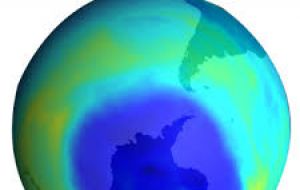MercoPress. South Atlantic News Agency
Antarctic ozone hole reached annual peak 11 September and with the size of North America
 Scientists are working to determine if the ozone hole trend over the last decade is a result of temperature increases or chorine declines.
Scientists are working to determine if the ozone hole trend over the last decade is a result of temperature increases or chorine declines. The Antarctic ozone hole reached its annual peak size on Sept. 11, according to scientists from NASA and the National Oceanic and Atmospheric Administration (NOAA). The size of this year’s hole was 24.1 million square kilometers, an area roughly the size of North America.
The single-day maximum area was similar to that in 2013, which reached 24.0 million square kilometers. The largest single-day ozone hole ever recorded by satellite was 29.9 million square kilometers on Sept. 9, 2000. Overall, the 2014 ozone hole is smaller than the large holes of the 1998–2006 period, and is comparable to 2010, 2012, and 2013.
With the increased atmospheric chlorine levels present since the 1980s, the Antarctic ozone hole forms and expands during the Southern Hemisphere spring (August and September). The ozone layer helps shield life on Earth from potentially harmful ultraviolet radiation that can cause skin cancer and damage plants.
The Montreal Protocol agreement beginning in 1987 regulated ozone depleting substances, such as chlorine-containing chlorofluorocarbons and bromine-containing halons. The 2014 level of these substances over Antarctica has declined about 9% below the record maximum in 2000.
“Year-to-year weather variability significantly impacts Antarctica ozone because warmer stratospheric temperatures can reduce ozone depletion,” said Paul A. Newman, chief scientist for atmospheres at NASA's Goddard Space Flight Center in Greenbelt, Maryland. “The ozone hole area is smaller than what we saw in the late-1990s and early 2000s, and we know that chlorine levels are decreasing. However, we are still uncertain about whether a long-term Antarctic stratospheric temperature warming might be reducing this ozone depletion.”
Scientists are working to determine if the ozone hole trend over the last decade is a result of temperature increases or chorine declines. An increase of stratospheric temperature over Antarctica would decrease the ozone hole’s area. Satellite and ground-based measurements show that chlorine levels are declining, but stratospheric temperature analyses in that region are less reliable for determining long-term trends.
Scientists also found that the minimum thickness of ozone layer this year was recorded at 114 Dobson units on Sept. 30, compared to 250-350 Dobson units during the 1960s. Over the last 50 years satellite and ground-based records over Antarctica show ozone column amounts ranging from 100 to 400 Dobson units, which translates to about 1 millimeter to 5 millimeters of ozone in a layer if all of the ozone were brought down to the surface.
The ozone data come from the Dutch-Finnish Ozone Monitoring Instrument on NASA’s Aura satellite and the Ozone Monitoring and Profiler Suite instrument on the NASA-NOAA Suomi National Polar-orbiting Partnership satellite.
NOAA measurements at South Pole station monitor the ozone layer above that location by means of Dobson spectrophotometer and regular ozone-sonde balloon launches that record the thickness of the ozone layer and its vertical distribution. Chlorine amounts are estimated using NOAA and NASA ground measurements and observations from the Microwave Limb Sounder aboard NASA’s Aura satellite. (NASA).-




Top Comments
Disclaimer & comment rules-

-

-

Read all commentsIf it gets bigger in the years to come it will envelop the Southern Cone.
Nov 09th, 2014 - 01:06 pm 0Ultra Violet radiation, cancer damage, crop damage - it would be better if this can be avoided.
I have been a beach person and year round sun absorber all my life. Have never used sunscreen and have only had a few and minor Basil Cell infections during my 75 years. I regularly visit the Dermatologist for yearly check ups and when I do I see Lily white patients covered with clothing and hats from head to toe and coated with sunscreen avoiding the sun completely. They are covered with bandages from recent operations of skin cancer. My belief is that the whole skin cancer, sunscreen, stay out of the sun thing is just a made up scam. When this ozone hole thing started the tanning companies panicked and quickly changed their production to sunscreen at a great expense. I would not be surprised to find out that when the scam was revealed they lobbied the AMA, NASA and supporting scientists to keep the scare alive so that they will not loose even more money changing back to tanning oils. The whole thing looks to me like a big money manipulating operation with the Tanning companies being the winner and the general public the looser. Oh by the way - the sun is our main source of vitamin D that builds up our immune system (that combats cancer cells and other viruses and diseases from infecting our bodies). See ya later I'm off to the beach and SUN!
Nov 09th, 2014 - 04:55 pm 0Wow,
Nov 09th, 2014 - 06:10 pm 0who'd have thought that the Nobel Prize Committee could get it sooo wrong!
Commenting for this story is now closed.
If you have a Facebook account, become a fan and comment on our Facebook Page!